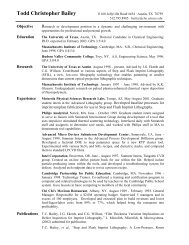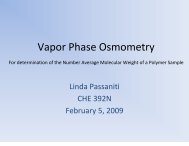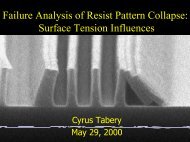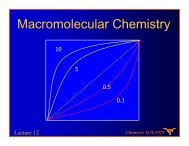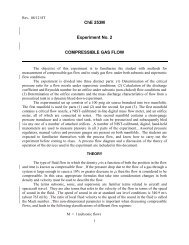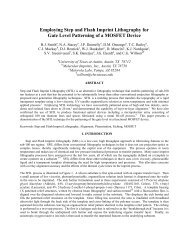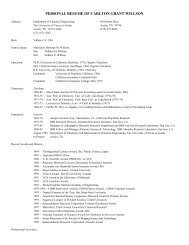commercial applications of block copolymers - Willson Research ...
commercial applications of block copolymers - Willson Research ...
commercial applications of block copolymers - Willson Research ...
- No tags were found...
Create successful ePaper yourself
Turn your PDF publications into a flip-book with our unique Google optimized e-Paper software.
COMMERCIALAPPLICATIONS OF BLOCKCOPOLYMERS
Outline History Usage Early products Thermoplastic elastomers Current research
History Anionic polymerization discovered in mid1950s First <strong>commercial</strong> <strong>block</strong> <strong>copolymers</strong> soonfollowed First hard-s<strong>of</strong>t <strong>block</strong> materials in late 1950s Thermoplastic elastomers (TPEs) comprisevast majority <strong>of</strong> production More recently, adhesives, surfactants,membranes, cosmetics
Block Copolymer Usage SBS 2005 consumption: 1.15 million tonsSource: China Chemical Reporter, Nov. 16, 2006 Total references: 110,099 References from last 5 years: 28,537 2008 references: 6,863 2009 references to date: 1,704Source: SciFinder Scholar
First Commerical Block Copolymer Surfactant, trade name “Pluronic” Addition <strong>of</strong> propylene oxide to ethylene oxidecarbanions, i.e. ring opening polymerizationHHHCH 3HHH C C O C C O C C O HHHHHHHABA <strong>block</strong> copolymer Ethylene oxide is hydrophilic, propylene oxide ishydrophobic Blocks typically 20+ monomer units
Spandex Invented in 1959 by Joseph Shivers <strong>of</strong> DuPont Originally “Fiber K” Step polymerization <strong>of</strong> polyether or polyester anddiisocyanate to form a polyurethaneOONHNHONHHN Not well defined, i.e. high polydispersities Urethane/urea linkages form stiff segments,poly(ethylene oxide) forms flexible segments
Spandex Fibers typically 85% segmentedpolyurethane Can stretch up to 600% and retainshape Blended with cotton, wool, othersynthetic fibers before use Does not break down with exposure toperspiration, oils, detergents
Thermoplastic Elastomers (TPEs) Most common <strong>block</strong> copolymer products Both thermoplastic and elastormericproperties Can be remelted and remolded Crosslinked bond network imparts elasticity○ Thermosets have covalent crosslinking○ TPEs have dipole or hydrogen bondcrosslinks Classes include styrenics,polyurethanes, segmented polyesters,and segmented polyamides
Polyurethane TPEs First <strong>commercial</strong>ly available TPEs B. F. Goodrich Co. in late 1950s Two step condensation polymerization Similar structure to spandex, urethane hydrogenbonding imparts strength and wear Used in automobile bumpers, snowmobile treads, etc.
Styrenic TPEs: Kraton Introduced by Shell in 1965 Polystyrene-b-polybutadiene(or polyisoprene)-bpolystyrene(SBS or SIS) Anionic polymerizationPS T g= 100°CPB T g= -70°C Linear molecules with homopolymer <strong>block</strong>s Low molecular weights and polydispersities
Styrenic TPEs: Others Tapered <strong>block</strong>s: Styr<strong>of</strong>lex Star <strong>block</strong>s: Solprene Typical styrene content 25to 40 wt% Uses include footwear,bitumen modification,molding products,adhesives, insulation
Polyester and Polyamide TPEs TPES produced by DuPont TPA produced by Huls and Ato Chimie(now part <strong>of</strong> Arkema) Step polymerization process similar topolyurethanes Ester (-CO-O-) or amide (-CO-NH-)linkages Applications in hose tubing, sportinggoods, automotive components
TPE Characteristics Microphase separationcaused by Crystallinity for TPES and TPA Hydrogen bonding for TPU andTPA van der Waals interactions forstyrenics TPEs not good for hightemperature or solventresistive service Exhibit mechanical hysteresis
TPE Characteristics Glassy, hard chains must anchor flexiblechains Tri<strong>block</strong> <strong>copolymers</strong> with polydiene end <strong>block</strong>s Di<strong>block</strong> <strong>copolymers</strong> Diene-containing TPEs reactive towardsoxygen Polybutadiene typically hydrogenized topoly(ethylene-co-butylene) Kraton family includes SIS, SBS, SEBS Kraton family represents 50% <strong>of</strong> TPE market Polycondesation TPEs represent 20% Polyolefin TPEs make up other 30%
Current <strong>Research</strong> Templating materialsPS-PEO surfacePE-PEO thin filmsRussel <strong>Research</strong> Group, UMass
Current <strong>Research</strong> NanocompositesPSBA-MMTShipp <strong>Research</strong> Group, Clarkson University
Current <strong>Research</strong> LithographyHawker <strong>Research</strong> Group, UCSB
Current <strong>Research</strong> Drug Delivery PLGA-PEGAkina, Inc.
Questions?
ReferencesCarraher, C. E. (2003). Seymour/Carraher's Polymer Chemistry.New York: Marcel Dekker.Hadjichristidis, N., Pispas. S., Floudas, G. A. Block Copolymers:Synthetic Strategies, Physical Properties, and Applications.Hoboken, New Jersey: John Wiley & Sons, Inc.



